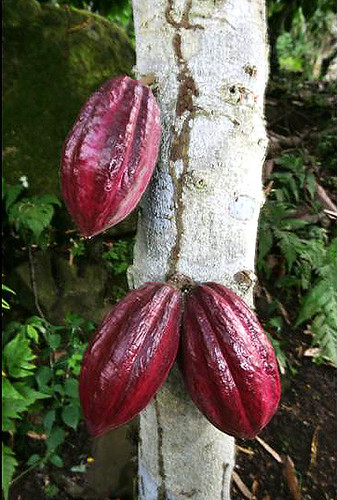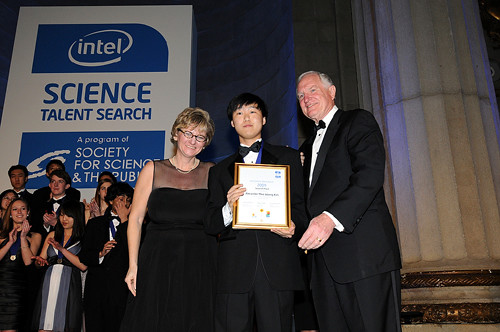I have some bad news (maybe) and some good news:
The image below is what might be our bad news. During GG III after the zoologists returned to Príncipe, our botanists and mycologists, Tom, Rebecca, Dennis and Brian did a little more work on the big island before flying home. The photo below was taken by Dr. Brian Perry on one of their last days on the islands, and I just learned of this discovery. The first image is of pods on a cacao tree by the roadside near a place called Bombaim, in mountainous central São Tomé. The cacao pods may be infested with a fungal pathogen known as frosty pod rot, Monilophthera roreri. This is a tentative identification by Brian and Dennis .

Frosty Pod Rot near Bombaim, Sao Tome Island. B. Perry phot - GG III
Cacao (or cocoa, the source of chocolate) is native to Central America and was brought first to Príncipe in the 1820’s by the Portuguese. During the Portuguese era the cacao industry on the islands was the largest in the world; based largely on slave labor, the industry declined at the end of the slave trade, and new plantations were established in Ghana by Cadburys, the one of the main European buyers and producers of chocolate. While the industry is now much reduced, it is still important to the economy of the Republic of São Tomé and Príncipe.

Healthy cacao pods on Sao Tome. D. Lin Phot. GG II
Frosty pod rot has devastated the cocoa industry in Central America from Mexico to Panama for over 50 years causing up to 80% crop losses in some localities. What we do not know is whether the growers of São Tomé and Príncipe know of the presence of this pathogen on the islands yet; we have just sent this picture together with the precise locality data to our friends in the Ministry of the Environment to alert them. We are hoping the authorities are already aware of the threat and have taken steps to deal with it. The whole frosty pod rot story can be found here:
http://www.worldcocoafoundation.org/info-center/documents/Phillips_Frosty_Pod_COPALPresentation.pdf.
(Addendum: 12/2009)
A sigh of relief...
... for São Tomé cocoa producers and chocolate lovers world-wide. We have just learnt from Ulrike Krauss that the suspected frosty pod rot on the photo taken near Bombaim is almost certainly either cherelle wilt or a pod mummified by secondary invaders following black pod rot, caused by Phytophthora sp, but not frosty pod rot. To date (December 2009), there is no confirmed record of the frosty pod rot pathogen, Moniliophthora roreri, in any of the cocoa-producing countries of the Old World.
Ulrike Krauss points out, however, that the threat of introduction is to be taken very seriously by authorities, as this pathogen is both highly invasive and extremely destructive. Natural spread from the Americas to the Old World is unlikely. Human vectoring, e.g. via cocoa germplasm, pods or beans, is the greatest risk, but the microscopic spores of the pathogen can also adhere to clothing and hair of anybody arriving from infested areas.

Alex Kim at Intel Awards - Media photo.
The good news is that Alex Kim, our high school colleague in Virginia who has been working on freshwater shrimp took 7th place at the 2009 Intel Science Talent Search. This is a remarkable achievement as the finalists included 40 of the most highly talented kids in the country. He is continuing his study of our São Tomé prawns and will keep us informed of his results; frankly I have a feeling we will be hearing a lot about this young man for years to come. Here is the url with descriptions of the projects, including Alex’s: http://sciserv.org/sts/68sts/winners.asp
Snakes are next in a return to “Slytherin”
The parting shot.

PARTNERS We gratefully acknowledge the support of the G. Lindsay Field Research Fund, Hagey Research Venture Fund of the California Academy of Sciences, the Société de Conservation et Développement (SCD) for logistics, ground transportation and lodging, STePUP of Sao Tome http://www.stepup.st/, Arlindo de Ceita Carvalho, Director General, and Victor Bomfim, Salvador Sousa Pontes and Danilo Bardero of the Ministry of Environment, Republic of São Tomé and Príncipe for permission to export specimens for study, and the continued support of Bastien Loloumb of Monte Pico and Faustino Oliviera, Director of the botanical garden at Bom Sucesso. Special thanks for the generosity of private individuals, George F. Breed, Gerry F. Ohrstrom, Timothy M. Muller, Mrs. W. H. V. Brooke and Mr. and Mrs. Michael Murakami for helping make these expeditions possible.